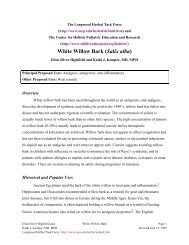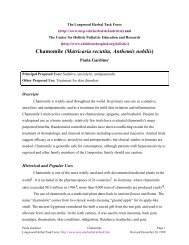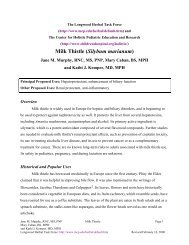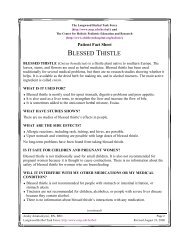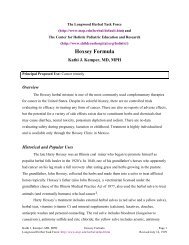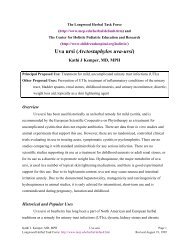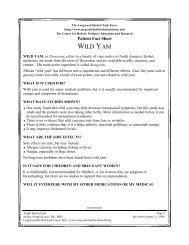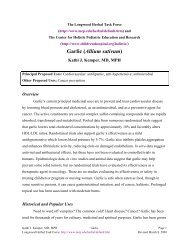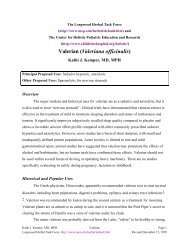Chasteberry (Vitex agnus castus) - Longwood Herbal Task Force
Chasteberry (Vitex agnus castus) - Longwood Herbal Task Force
Chasteberry (Vitex agnus castus) - Longwood Herbal Task Force
Create successful ePaper yourself
Turn your PDF publications into a flip-book with our unique Google optimized e-Paper software.
The <strong>Longwood</strong> <strong>Herbal</strong> <strong>Task</strong> <strong>Force</strong><br />
(http://www.mcp.edu/herbal/default.htm) and<br />
The Center for Holistic Pediatric Education and Research<br />
(http://www.childrenshospital.org/holistic/)<br />
<strong>Chasteberry</strong> (<strong>Vitex</strong> <strong>agnus</strong> <strong>castus</strong>)<br />
Paula Gardiner, MD<br />
Principal proposed uses: Corpus luteum insufficiency, premenstrual syndrome, mastalgia, and<br />
other menstrual problems<br />
Other proposed uses: Lactagogue, menopausal symptoms, acne<br />
Overview<br />
<strong>Vitex</strong> <strong>agnus</strong> <strong>castus</strong> (<strong>Chasteberry</strong>) is a popular treatment for the management of female<br />
reproductive disorders including corpus luteum insufficiency, premenstrual syndrome (PMS),<br />
menopausal symptoms, and insufficient milk production. The German Commission E<br />
recommends it for menstrual problems, mastalgia, and premenstrual syndrome 1 . The specific<br />
chemical components responsible for its clinical effects have not been determined. One proposed<br />
mechanism is an effect on the pituitary’s release of prolactin. Small randomized controlled trials<br />
indicate that vitex may be helpful in hyperprolactinemia, PMS and cyclical breast pain. Further<br />
research is needed to access its efficacy and safety for use by lactating mothers. There are no<br />
studies of its effects on menopausal symptoms or its safety in pregnancy. Side effects are rare<br />
and include rash, GI disorders, headache and increased menstrual flow.<br />
Historical and Popular Uses<br />
<strong>Chasteberry</strong> derives its common name from the belief that the plant inspires chastity. It<br />
was used in ancient Greece and Rome to diminish sexual desire. Monks in the Middle Ages used<br />
it for the same purpose, leading to its common name, “Monk’s pepper”. This purple-flowered<br />
shrub of the verbena family grows in the Mediterranean countries and central Asia.<br />
A standardized preparation of chasteberry has been available in Germany since the<br />
1950’s, and is used to treat ovarian insufficiency and uterine bleeding 2 . The German<br />
Paula Gardiner <strong>Chasteberry</strong> Page 1<br />
<strong>Longwood</strong> <strong>Herbal</strong> <strong>Task</strong> <strong>Force</strong>: http://www.mcp.edu/herbal/default.htm Revised May 11, 2000
Commission E recommends vitex for the treatment for menstrual problems, mastalgia, and<br />
PMS 1 . It has been used to treat fibroid cysts and infertility 3 , to stop miscarriages caused by<br />
progesterone insufficiency and to flush out the placenta after birth 4, 5 . German health authorities<br />
recommend its use for corpus luteum insufficiency, menopausal symptoms and inadequate milk<br />
production in nursing mothers 4 . It is used to treat acne in teenagers 6 . It has also been<br />
traditionally used as a digestive aid, sedative and anti-infective 3 .<br />
Botany<br />
Medicinal species: <strong>Vitex</strong> <strong>agnus</strong> <strong>castus</strong><br />
Common names: Abraham’s balm, chasteberry, chaste tree fruit, monk’s pepper, safe tree, hemp<br />
tree, vitex<br />
Botanical family: Verbenaceae<br />
Plant description: A shrub or small deciduous tree that bears slender spikes of violet-blue, 8-10<br />
cm flowers. The medicinal part of the plant is its peppercorn-sized fruit. The berries are<br />
aromatic and have a peppery taste 7 .<br />
Where it’s grown: Asia, Europe (especially Mediterranean regions), North America<br />
Paula Gardiner <strong>Chasteberry</strong> Page 2<br />
<strong>Longwood</strong> <strong>Herbal</strong> <strong>Task</strong> <strong>Force</strong>: http://www.mcp.edu/herbal/default.htm Revised May 11, 2000
Biochemistry<br />
<strong>Vitex</strong> Agnus Castus: Potentially Active Chemical Constituents<br />
• Iridoid glycosides: agnoside, aucubin<br />
• Flavonoids: casticin, kampferol, quercetagetin, vitexin 8<br />
• Progestins: progesterone, hydroxyprogesterone (flowers and leaves), testosterone,<br />
epitestosterone (flowers), androstenedione (leaves) 8<br />
• Alkaloids: viticin<br />
• Volatile oil: 1,8-cineol, limes, linalool, terpinyl acetate,alpha pinenes and beta pinenes9, 10<br />
• Essential fatty acids: palmitic acid, oleic acid, linoleic acid, stearic acid 10<br />
<strong>Vitex</strong>’ precise mechanism of action and its active constituents have not been<br />
established 2 . Some constituents may have anti-inflammatory, sedative, and analgesic properties.<br />
<strong>Vitex</strong> also has dopaminergic properties, although it remains unclear which active compound is<br />
responsible.<br />
The iridoid glycoside aucubin constituted 0.3% of vitex’s leaves in one survey, and its p-<br />
hydroxybehzoyl derivative, <strong>agnus</strong>ide, constituted 0.7%; unidentified glycosides constituted<br />
0.07% 2 .<br />
The flavonoid content has been determined in chaste tree leaves (1.0-2.7%), flowers (1.0-<br />
1.5%) and fruits (0.5-1.0%) 8 . The berries contain 5% volatile oil.<br />
Paula Gardiner <strong>Chasteberry</strong> Page 3<br />
<strong>Longwood</strong> <strong>Herbal</strong> <strong>Task</strong> <strong>Force</strong>: http://www.mcp.edu/herbal/default.htm Revised May 11, 2000
Experimental Studies<br />
1. Cardiovascular: none<br />
2. Pulmonary: none<br />
3. Renal and electrolyte balance: none<br />
4. Gastrointestinal/hepatic: none<br />
5. Neuro-psychiatric: none<br />
<strong>Vitex</strong> Agnus Castus: Potential Clinical Benefits<br />
6. Endocrine: See Reproductive: hyperprolactinemia<br />
7. Hematologic: none<br />
8. Rheumatologic: none<br />
9. Reproductive: Infertility, premenstrual syndrome, cyclic mastalgia, lactagogue,<br />
hyperprolactinemia, abnormal menstrual cycles<br />
10. Immune modulation: none<br />
11. Antimicrobial: Antibacterial and antifungal<br />
12. Antineoplastic: none<br />
13. Antioxidant: none<br />
14. Skin and mucus membranes: Acne<br />
15. Other/miscellaneous: none<br />
1. Cardiovascular: none<br />
2. Pulmonary: none<br />
3. Renal and electrolyte imbalance: none<br />
4. Gastrointestinal/hepatic: none<br />
5. Neuro-psychiatric: none<br />
6. Endocrine: See Reproductive: Hyperprolactinemia<br />
7. Hematologic: none<br />
8. Rheumatologic: none<br />
9. Reproductive: Infertility, premenstrual syndrome, cyclic mastalgia, lactagogue,<br />
hyperprolactinemia, abnormal menstrual cycles. Numerous studies have investigated the use<br />
of vitex to treat symptoms of corpus luteum insufficiency such as irregular menstrual cycles,<br />
Paula Gardiner <strong>Chasteberry</strong> Page 4<br />
<strong>Longwood</strong> <strong>Herbal</strong> <strong>Task</strong> <strong>Force</strong>: http://www.mcp.edu/herbal/default.htm Revised May 11, 2000
dysfunctional uterine bleeding, mastodynia, and PMS 2 . There have been approximately four<br />
open human trials on vitex’s use in hormone imbalance syndromes; all demonstrated positive<br />
results 3 . Clinical studies have focused on the treatment of PMS and mastodynia, and a few<br />
studies exist in patients with secondary amenorrhea, hyperprolactinemia, and corpus luteum<br />
insufficiency. Again, the results have been promising. There have been no clinical studies on<br />
the treatment of menopausal symptoms.<br />
a. Infertility<br />
i. In vitro data: <strong>Vitex</strong> inhibited the spontaneous activity of the isolated rat uterus and<br />
did not demonstrate anti-fertility effects 11 .<br />
ii. Animal data: none<br />
iii. Human data: In a randomized, prospective, placebo controlled double blind study, 96<br />
women with fertility disorders took the vitex preparation Mastodynon ® (30 drops<br />
twice a day) or placebo for three months. The outcome measures, which were a)<br />
pregnancy, b) spontaneous menstruation in women with amenorrhoea and/or<br />
subsequent pregnancy, or c) improved concentrations of luteal hormones, were<br />
achieved significantly more often in the Mastodynon group compared to the placebo<br />
group (57.6% versus 36.0%, p = 0.069). In women with amenorrhoea or luteal<br />
insufficiency, pregnancy occurred more than twice as often in the Mastodynon group<br />
as in the placebo group 12 .<br />
b. Premenstrual syndrome: Large open studies and several randomized controlled trials have<br />
shown conflicting results in the use of vitex to treat PMS symptoms.<br />
i. In vitro data: See endocrine.<br />
ii. Animal data: none<br />
iii. Human data: Case studies have noted an effect of vitex on premenstrual aggravations<br />
such as mouth ulcers, acne, and premenstrual edema 10 . A monograph on vitex noted<br />
a monitoring survey to study the effect of the liquid vitex extract Agnolyt ® (40 drops<br />
daily) in 1542 women with PMS, ages 13 to 62. After an average of four months,<br />
both patients and physicians assessed the efficacy of treatment. Thirty-three percent<br />
of the patients reported total relief of their symptoms, and an additional 57% reported<br />
partial relief. Seventy-one percent of physicians reported good to very good efficacy<br />
Paula Gardiner <strong>Chasteberry</strong> Page 5<br />
<strong>Longwood</strong> <strong>Herbal</strong> <strong>Task</strong> <strong>Force</strong>: http://www.mcp.edu/herbal/default.htm Revised May 11, 2000
of treatment. Two percent of patients reported side effects including nausea, allergy,<br />
diarrhea, weight gain, giddiness, heartburn, hypermenorrhea, gastric complaints,<br />
acne, pruritus, erythema, alopecia, and cardiac palpitations. Seventeen of the 1542<br />
women stopped the study due to side effects. Five hundred sixty-two patients<br />
continued to take Agnolyt after the monitoring period 13, 14 .<br />
In an open study (reported in a monograph on vitex), 36 patients with PMS<br />
who used 40 drops of Agnolyt daily for three months noted reductions in headaches,<br />
breast tenderness, bloating, fatigue, appetite, sweet cravings, nervousness,<br />
restlessness, anxiety, irritability, lack of concentration, depression, mood swings, and<br />
aggressiveness 13, 15 .<br />
A three-month randomized, placebo controlled study of 127 women, ages 18<br />
to 45, with PMS compared Agnolyt ® (one capsule daily containing 3.5-4.2 mg of a<br />
dried vitex extract) to vitamin B6 (100 mg twice per day) for day 16-35 of the<br />
menstrual cycle. The vitex and vitamin B6 groups had similar reductions in<br />
premenstrual tension syndrome scale scores (six typical premenstrual symptoms);<br />
77% of those in the vitex group and 66% of those in the vitamin B6 group had<br />
improvement in the clinical global impressions scale. Side effects included<br />
gastrointestinal and lower abdominal complaints (equally distributed between the two<br />
groups), skin reactions (two subjects in the vitex group) and transitory headache (one<br />
subject in the vitex group) 16, 17 .<br />
In a multicenter controlled double blind study, women ages 18 to 45 with<br />
PMS took a vitex tincture (1:5, 175 mg/day) or pyridoxine (200 mg/day). The total<br />
symptom score decreased comparably in the two groups 7, 18 .<br />
A randomized, double blind, placebo controlled study in 217 subjects with<br />
PMS compared vitex (600 mg capsules three times a day) to placebo for three<br />
months. <strong>Vitex</strong> was statistically more effective than placebo only in alleviating jitters<br />
and restlessness; there was no statistical significant difference for other PMS<br />
symptoms including impaired concentration, fluid retention, or pain 19 .<br />
Paula Gardiner <strong>Chasteberry</strong> Page 6<br />
<strong>Longwood</strong> <strong>Herbal</strong> <strong>Task</strong> <strong>Force</strong>: http://www.mcp.edu/herbal/default.htm Revised May 11, 2000
No randomized controlled trials have compared long-term treatment with<br />
vitex to standard medical treatments such as birth control pills or antidepressants, or<br />
evaluated its interactions with standard treatment.<br />
c. Cyclic mastalgia: Open studies and three placebo-controlled trials support the use of vitex<br />
in treating cyclic mastalgia.<br />
i. In vitro data: See Endocrine.<br />
ii. Animal data: none<br />
iii. Human data: In an open study, 52 women with cyclic mastalgia took 30 drops of<br />
vitex extract twice a day for three months; most women reported disappearance or<br />
improvement of symptoms 3 .<br />
In a pilot study, 56 women with mastodynia who took a product containing<br />
chasteberry for three menstrual cycles had significantly reduced serum prolactin<br />
levels compared to those taking placebo 7 .<br />
In a randomized, double blind, crossover, placebo-controlled study in 20<br />
women with cyclic mastalgia, women who received three months of treatment with<br />
Mastodynon ® (a vitex extract) had significant relief of symptoms compared to those<br />
who took placebo 3, 20 .<br />
In a double blind, placebo controlled study of 100 women with cyclic breast<br />
pain, 1.8 ml of vitex extract daily for three months reduced menstrual associated<br />
breast pain 21 .<br />
d. Lactagogue<br />
i. In vitro data: none<br />
ii. Animal data: In healthy lactating rats, high doses of vitex reduced milk production<br />
significantly compared to controls 3 . On the other hand, other animal studies have<br />
found an increase in lactation and mammary enlargement 2 .<br />
iii. Human data: Two early studies found a favorable effect of vitex on milk production.<br />
A 1943 study found an increase in milk production in 80% of 125 patients 10 . In a<br />
1957 controlled trial in 817 patients, there was a significant effect from vitex<br />
administration, with average milk production about three times that of controls after<br />
20 days of treatment 10, 22 .<br />
Paula Gardiner <strong>Chasteberry</strong> Page 7<br />
<strong>Longwood</strong> <strong>Herbal</strong> <strong>Task</strong> <strong>Force</strong>: http://www.mcp.edu/herbal/default.htm Revised May 11, 2000
e. Hyperprolactinemia (See also Abnormal menstrual cycles, below.)<br />
i. In vitro data: <strong>Vitex</strong> inhibits prolactin release and binds to dopamine receptors 23-25 .<br />
It does not appear to inhibit the rat pituitary cell production of follicle stimulation<br />
hormone (FSH) or luteinizing hormone (LH) 23 .<br />
ii. Animal data: <strong>Vitex</strong> inhibited the secretion of prolactin in rats 24 .<br />
iii. Human data: In a placebo controlled crossover double-blind study of 20 healthy men,<br />
vitex had different effects on prolactin release at different concentrations. Men<br />
received doses of 120 mg, 240 mg or 480 mg of a special vitex extract (BP1095E1)<br />
daily for 14 days. There was a significant increase in prolactin level in men receiving<br />
the lowest dose, but a slight reduction in prolactin level in those receiving the higher<br />
doses 26 . There were no significant dose-dependent changes in the 24-hour serum<br />
prolactin profile. The changes that occurred during the treatment period depended on<br />
the baseline prolactin levels of the individual subjects 7 .<br />
See Abnormal menstrual cycles below for studies in women with<br />
hyperprolactinemia.<br />
f. Abnormal menstrual cycles<br />
i. In vitro data: none<br />
ii. Animal data: none<br />
iii. Human data: Numerous German open studies noted in the literature, including one<br />
dating back to the 1950’s, have found a positive effect on vitex use in regulating the<br />
menstrual cycle 27-30 .<br />
In an open trial, 1,592 women (average age of 32) with corpus luteum<br />
insufficiency presenting as hypermenorrhea (418), polymenorrhea (359), secondary<br />
amenorrhea (202), dysmenorrhea (186), PMS anovulation (175), sterility (145),<br />
menorrhagia (66), and disturbed menstruation (32) received vitex extract (40 drops<br />
daily) for six months. Sixty one percent of the patients reported a good outcome, and<br />
physicians noted that 33% of patients were free of complaints and that there was a<br />
positive response to treatment in 51% of the patients 3, 31 .<br />
In a randomized double blind study, 52 women with menstrual cycle<br />
disturbances due to luteal phase defect and latent hyperprolactinemia received 20 mg<br />
Paula Gardiner <strong>Chasteberry</strong> Page 8<br />
<strong>Longwood</strong> <strong>Herbal</strong> <strong>Task</strong> <strong>Force</strong>: http://www.mcp.edu/herbal/default.htm Revised May 11, 2000
daily of Strotan ® (an aqueous alcoholic extract of the vitex fruit) or placebo for three<br />
months. The subjects in the vitex group had a significant reduction in prolactin<br />
release, normalization of a shortened luteal phase, normalization of luteal<br />
progesterone synthesis, and significant reduction of their PMS symptoms compared<br />
to those receiving placebo. No side effects were reported 32 .<br />
10. Immune modulation: none<br />
11. Antimicrobial: Antibacterial and antifungal<br />
i. In vitro data: <strong>Vitex</strong> demonstrated antimicrobial activity against Staphylococcus aureus,<br />
Streptococcus faecalis, Salmonella species, Escherichia coli (10-20%), Candida<br />
albicans, C. tropicalis, C. pseudotropicalis, and C. krusei (10-40%). <strong>Vitex</strong> extracts<br />
inhibited the growth of the dermatophytes and molds species: Trichophyton<br />
mentagrophytes, Epidermophyton floccosum, Microsporum canis and M. gypseum 33 .<br />
ii. Animal data: none<br />
iii. Human data: none<br />
12. Antineoplastic: none<br />
13. Antioxidant: none<br />
14. Skin and mucus membranes: Acne. A few clinical studies have investigated vitex’ use in<br />
the treatment of acne 6, 34 .<br />
i. In vitro data: none<br />
ii. Animal data: none<br />
iii. Human data: In a controlled trial of 161 acne patients, reported in a monograph on vitex,<br />
three months minimum treatment with vitex resulted in an improvement in 70% of<br />
patients, a result which was significantly better than placebo 10, 35 .<br />
15. Other/miscellaneous: none<br />
Paula Gardiner <strong>Chasteberry</strong> Page 9<br />
<strong>Longwood</strong> <strong>Herbal</strong> <strong>Task</strong> <strong>Force</strong>: http://www.mcp.edu/herbal/default.htm Revised May 11, 2000
Toxicity and Contraindications<br />
All herbal products carry the potential for contamination with other herbal products, pesticides,<br />
herbicides, heavy metals, and pharmaceuticals, etc.<br />
Furthermore, allergic reactions can occur to any natural product in sensitive persons.<br />
Allergic reactions to vitex have not been reported.<br />
Potentially toxic compounds in vitex: None known 7, 9 .<br />
Acute toxicity: Side effects are rare and may include itching, rash, headache, hair loss, fatigue,<br />
agitation, dry mouth, tachycardia, nausea and increased menstrual flow 2, 8 . There is one<br />
case report of mild ovarian hyperstimulation in a woman who self-prescribed vitex 36 .<br />
Chronic toxicity: Unknown<br />
Limitations during other illnesses or in patients with specific organ dysfunction: Unknown<br />
Interactions with other herbs or pharmaceuticals: There are no reports of herb-drug interactions<br />
involving vitex. Some herbalists believe that vitex could interfere with birth control pills,<br />
hormone replacement therapy, and other hormone replacement medication 2, 5 .<br />
Additionally, it has been hypothesized that individuals taking drugs classified as<br />
dopamine-receptor antagonists should use caution when taking vitex because animal<br />
studies indicate that vitex may interfere with the dopamine receptor 1, 4 .<br />
Safety during pregnancy, lactation and/or childhood: There are no clinical studies assessing the<br />
safety of vitex in children and pregnant women. <strong>Vitex</strong> is generally not recommended in<br />
pregnancy due to its unknown effects on the pituitary. There is insufficient information<br />
on the safety of using vitex during nursing. However, analysis for breast milk revealed no<br />
changes in composition 2 .<br />
Paula Gardiner <strong>Chasteberry</strong> Page 10<br />
<strong>Longwood</strong> <strong>Herbal</strong> <strong>Task</strong> <strong>Force</strong>: http://www.mcp.edu/herbal/default.htm Revised May 11, 2000
Typical Dosages<br />
Provision of dosage information dose NOT constitute a recommendation or endorsement, but<br />
rather indicates the range of doses commonly used in herbal practice.<br />
Doses are given for single herb use and must be adjusted when using herbs in combinations.<br />
Doses may also vary according to the type and severity of the condition treated and individual<br />
patient conditions.<br />
A wide range of dosages are recommended by herbalists and used in clinical trails. Clinical trials<br />
to treat PMS have used anywhere from 3.5–4.5 mg/day of dried extract to 600 mg three times per<br />
day of dried fruit.<br />
Examples of adult dosages:<br />
Aqueous alcoholic extracts in 50-70% alcohol (v/v): Amount corresponding to 30-40 mg<br />
of dried fruit daily:<br />
Fluid extract (1:1 g/ml): 0.03-0.04 ml daily<br />
Tincture (1:5 g/ml): 0.15-0.2 ml daily<br />
Dried extract (9.5-11.5:1 w/w): 2.6-4.2 mg daily 37<br />
Powdered extract: 175-225 mg chasteberry extract in tablet or capsule daily 16 .<br />
Whole fruit: 0.5-1.0 g three times daily 2<br />
Pediatric dosages: Unknown<br />
Availability of standardized preparations: Standardized preparations used in Europe include<br />
Agnolyt ® ; Strotan ® ; and Mastodynon ® . Examples of standardized products available in<br />
the US include Chaste Tree Berry Extract from Enzymatic Therapy, standardized to<br />
0.5% <strong>agnus</strong>ide; Power Herbs <strong>Chasteberry</strong> Power from Nature’s Herbs, standardized to a<br />
minimum of 0.9% glycosides and combined with dong quai and Siberian ginseng; and a<br />
Nutritional Dynamics product standardized to 0.5% <strong>agnus</strong>ide and 0.6% aucubin 16 .<br />
Dosages used in herbal combinations: Variable<br />
Paula Gardiner <strong>Chasteberry</strong> Page 11<br />
<strong>Longwood</strong> <strong>Herbal</strong> <strong>Task</strong> <strong>Force</strong>: http://www.mcp.edu/herbal/default.htm Revised May 11, 2000
See Also:<br />
<strong>Vitex</strong> Clinician Information Summary: http://www.mcp.edu/herbal/vitex/vitex.cis.pdf<br />
<strong>Vitex</strong> Patient Fact Sheet: http://www.mcp.edu/herbal/vitex/vitex.ph.pdf<br />
Paula Gardiner <strong>Chasteberry</strong> Page 12<br />
<strong>Longwood</strong> <strong>Herbal</strong> <strong>Task</strong> <strong>Force</strong>: http://www.mcp.edu/herbal/default.htm Revised May 11, 2000
REFERENCES<br />
1. Blumenthal M. The complete German Commission E monographs : therapeutic guide to herbal medicines.<br />
Austin: American Botanical Council, 1998.<br />
2. Newall CA, Anderson LA, Phillipson JD. <strong>Herbal</strong> medicines : a guide for health-care professionals. London:<br />
Pharmaceutical Press, 1996:ix, 296.<br />
3. Christie S, Walker A. <strong>Vitex</strong> <strong>agnus</strong> <strong>castus</strong>, A review of its traditional and modern therapeutic use, current<br />
use from a survey of practitioners. The European Journal of <strong>Herbal</strong> Medicine 1997; 3:29 -45.<br />
4. Peirce A. The American Pharmaceutical Association practical guide to natural medicines. New York:<br />
William Morrow and Company, Inc., 1999.<br />
5. McGuffin M, Hobbs C, Upton R, Goldberg A. American <strong>Herbal</strong> Products Association's Botanical Safety<br />
Handbook. Boca Raton. New York: CRC Press, 1997:231.<br />
6. Amann W. [Improvement of acne vulgaris following therapy with <strong>agnus</strong> <strong>castus</strong> (Agnolyt)]. Ther Ggw<br />
1967; 106:124-6.<br />
7. Schulz V, Hansel R, Tyler VE. Rational Phytotherapy: A Physicians' Guide to <strong>Herbal</strong> Medicine. Berlin:<br />
Springer, 1997:306.<br />
8. Anonymous. Chaste Tree. In: Dombek C, ed. Lawerence Review of Natural Products. St. Louis: Facts and<br />
Comparisons, 1998.<br />
9. Fleming T. PDR for herbal medicines. Montvale, NJ: Medical Economics Company, Inc., 1998.<br />
10. Du Mee C. <strong>Vitex</strong> <strong>agnus</strong> <strong>castus</strong>. Aust J Med <strong>Herbal</strong>ism 1993; 5:63-65.<br />
11. Lal R, Sankaranarayanan A, Mathur VS, Sharma PL. Antifertility and Oxytocic Activity of <strong>Vitex</strong>-Agnus-<br />
Castus Seeds in Female Albino Rats. Bulletin of Postgraduate Institute of Medical Education and Research<br />
Chandigarh 1985; 19:44-47.<br />
12. Gerhard I, Patek A, Monga B, Blank A, Gorkow C. Mastodynon(R) bei we iblicher Sterilit#t. Forsch<br />
Komplementarmed 1998; 5:272-278.<br />
13. Brown D. <strong>Vitex</strong> <strong>agnus</strong> <strong>castus</strong> clinical monograph. Quarterly Review of Natural Medicine 1994; 06-30-<br />
94:111-121.<br />
14. Dittmar F, Bohnert K. Premenstrual Syndrome: Treatment with a phytopharmceutical. TW Gynakol 1992;<br />
5:60-68.<br />
15. Coeugniet E. Premenstrual syndrome and its treatment. Arztezeitchr Naturheilverf 1986; 27:619-622.<br />
16. Klepser T, Nisly N. Chaste Tree Berry for Premenstrual Syndrome. Alternative Medicine Alert 1999;<br />
June:64-67.<br />
17. Lauritzen C, Reuter H, Repges R. Treatment of premenstrual tension syndrome with <strong>Vitex</strong> <strong>agnus</strong> <strong>castus</strong>:<br />
controled double blind study versus pyridoxine. Phytomedicine. 1997; 4:183-189.<br />
18. Reuter H, al e. Die Therapie des pramenstrullen syndromes mit <strong>Vitex</strong> <strong>agnus</strong> <strong>castus</strong>. Kontrollierte<br />
doppelblindstrdie gegen pyridoxin. Z Pyhtotherapy Abstractband 1995:7.<br />
Paula Gardiner <strong>Chasteberry</strong> Page 13<br />
<strong>Longwood</strong> <strong>Herbal</strong> <strong>Task</strong> <strong>Force</strong>: http://www.mcp.edu/herbal/default.htm Revised May 11, 2000
19. Turner S, Mills S. A double-blind clinical trial on a herbal remedy for premenstrual syndrome; a case<br />
study. complementary therapies in medicine 1993; 1:73-77.<br />
20. Kubista E, al e. Conservative treatment of mastitis. Z Gynakologie 1983; 105:1153-1162.<br />
21. Halaska M, Raus K, Beles P, Martan A, Paithner KG. [Treatment of cyclical mastodynia using an extract of<br />
<strong>Vitex</strong> <strong>agnus</strong> <strong>castus</strong>: results of a double-blind comparison with a placebo]. Ceska Gynekol 1998; 63:388-92.<br />
22. Mohr H. Clinical investigations of means to increase lactation. Dtsch Med Wschr 1954; 79:1513.<br />
23. Jarry H, Leonhardt S, Gorkow C, Wuttke W. In vitro prolactin but not LH and FSH release is inhibited by<br />
compounds in extracts of Agnus <strong>castus</strong>: direct evidence for a dopaminergic principle by the dopamine<br />
receptor assay. Exp Clin Endocrinol 1994; 102:448-54.<br />
24. Winterhoff H. Arnzneiepflanzen mit endokriner Wirksamkei. A Phytother. 1993; 14:83-94.<br />
25. Sliutz G, Speiser P, Schultz AM, Spona J, Zeillinger R. Agnus <strong>castus</strong> extracts inhibit prolactin secretion of<br />
rat pituitary cells. Horm Metab Res 1993; 25:253-5.<br />
26. Merz PG, Gorkow C, Schrodter A, Rietbrock S, Sieder C, Loew D, et al. The effects of a special Agnus<br />
<strong>castus</strong> extract (BP1095E1) on prolactin secretion in healthy male subjects. Exp Clin Endocrinol Diabetes<br />
1996; 104:447-53.<br />
27. Probst V, Roth O. On a plant extract with a hormone like effect. Dtsch Med Wschr 1954; 79:1271- 4.<br />
28. Bleier W. Phytotherapy in irregular menstrual cycles or bleeding periods andothe gynecological disorders<br />
of endocrine origin. Zentralblatt Gynakol 1959; 81:701-9.<br />
29. Losh E. Diagnosis and treatment of dyshormaonal menstrual periods in the general practice. Gynakol<br />
Praxis 1990; 14:489-495.<br />
30. Propping D. Treatment of corpus leueum insufficiency. Zeits Allfemeinmedizin 1987; 63.<br />
31. Propping D, al e. <strong>Vitex</strong> <strong>agnus</strong> <strong>castus</strong> tratment of gynacological syndromes. Therapeutikon 1991; 5:581- 5.<br />
32. Milewicz A, Gejdel E, Sworen H, Sienkiewicz K, Jedrzejak J, Teucher T, et al. [<strong>Vitex</strong> <strong>agnus</strong> <strong>castus</strong> extract<br />
in the treatment of luteal phase defects due to latent hyperprolactinemia. Results of a randomized placebo-<br />
controlled double-blind study]. Arzneimittelforschung 1993; 43:752-6.<br />
33. Pepeljnjak S, Antolic A, Kustrak D. Antibacterial and antifungal activities of the <strong>Vitex</strong> <strong>agnus</strong>-<strong>castus</strong> L.<br />
extracts. Acta Pharmaceutica Zagreb 1996; 46:201-206.<br />
34. Amann W. [Acne vulgaris and Agnus <strong>castus</strong> (Agnolyt)]. Z Allgemeinmed 1975; 51:1645-8.<br />
35. Giss G, al e. Haut-und Gesch 1968; 43:645.<br />
36. Cahill DJ, Fox R, Wardle PG, Harlow CR. Multiple follicular development associated with herbal medicine<br />
[see comments]. Hum Reprod 1994; 9:1469-70.<br />
37. Blumenthal M. <strong>Herbal</strong> medicine : expanded Commission E monographs. Austin, TX: American Botanical<br />
Council, 2000.<br />
Paula Gardiner <strong>Chasteberry</strong> Page 14<br />
<strong>Longwood</strong> <strong>Herbal</strong> <strong>Task</strong> <strong>Force</strong>: http://www.mcp.edu/herbal/default.htm Revised May 11, 2000



